Discover 35 hidden attractions, cool sights, and unusual things to do in Ann Arbor (United States). Don't miss out on these must-see attractions: Stearns Collection of Musical Instruments, Matthaei Botanical Gardens, and University of Michigan Museum of Art. Also, be sure to include Yost Ice Arena in your itinerary.
Below, you can find the list of the most amazing places you should visit in Ann Arbor (Michigan).
Table of Contents
Stearns Collection of Musical Instruments
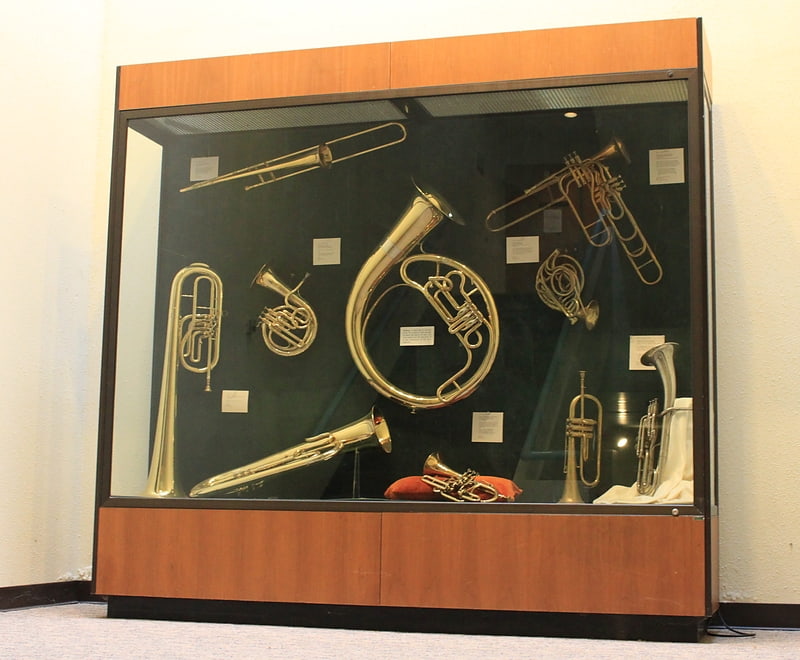
The Stearns Collection of Musical Instruments, held by the University of Michigan's School of Music, Theatre & Dance in Ann Arbor, Michigan, consists of over 2,500 historical and contemporary musical instruments from around the world. The basis of the Collection is a gift made to the University by pharmaceutical businessman Frederick Stearns in 1898. Known internationally as a unique research collection, its holdings include the trumpet collection of Armando Ghitalla, former principal trumpet player of the Boston Symphony Orchestra and University of Michigan faculty member; a collection of violin bows from Jerry Tetewsky; as well as Robert Moog's first commercially produced Moog synthesizer from 1964 and the RCA theremin used during the WXYZ broadcasts of the Green Hornet from 1936-1952. A Catalog documenting the Collection's holdings was published in 1918 by Albert A. Stanley, with a second edition published in 1921. In 1988, Professor James M. Borders published a catalog featuring the Collection's European and American wind and percussion instruments.
The museum's collections include a number of forged or altered items, purchased by the founder from the notorious Italian instrument dealer Leopoldo Franciolini. The museum's web site and signage are unusual among musical instrument museums for the scrupulous care with which these items are identified.
The collection is exhibited in the lower lobby of the University's Hill Auditorium on the Central Campus and at the Earl V. Moore Building on the North Campus.[1]
Address: 1100 Baits Dr, Ann Arbor (Northeast Ann Arbor)
Matthaei Botanical Gardens
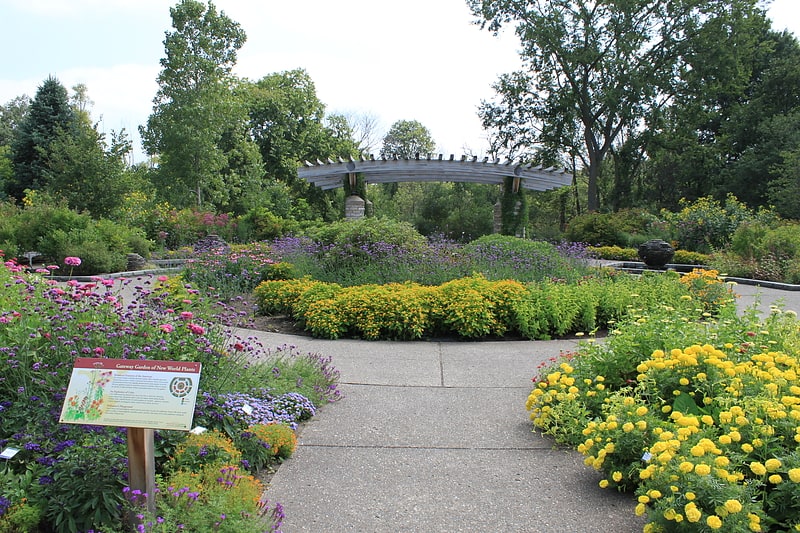
Botanical garden in Ann Arbor Charter Township, Michigan. The University of Michigan Matthaei Botanical Gardens includes botanical gardens, natural areas with trails, and several research-quality habitats. The conservatory is popular year round. The public entrance is at 1800 North Dixboro Road in Ann Arbor, Michigan. The grounds are open every day, but trails are not maintained in the winter. The conservatory, garden store, and lobby are open 7 days a week: Mon. Tues. and Thurs. - Sun. 10:00 am–4:30 pm; Wednesdays 10 am-8 pm. The building complex is only closed on three holidays a year. The institution's main web site with updated information is Matthaei Botanical Gardens.
The botanical gardens includes outdoor display gardens, the Gaffield Children's Garden, a 10,000+ square-foot conservatory, and natural areas with walking trails. The gardens are named after former Michigan regent Frederick C. Matthaei Sr. and his wife Mildred, who donated 200 acres (0.81 km2) of land.
Matthaei Botanical Gardens offers activities and resources for all visitors, from families to gardening enthusiasts to hikers, birders, scientists, volunteers, and to University of Michigan faculty, staff, and students. The gardens is dedicated to environmental stewardship and to enriching the understanding and enjoyment of the natural world through research, creative works, public outreach, and educational programs and workshops for adults and children.[2]
University of Michigan Museum of Art
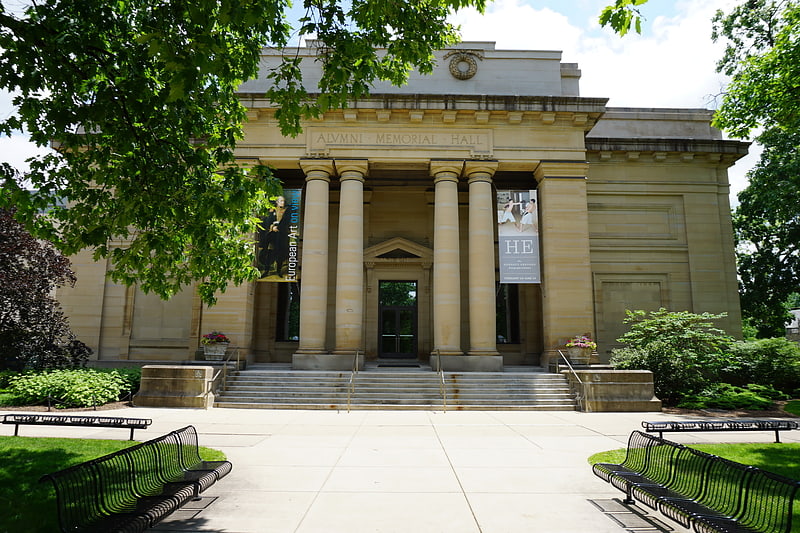
Museum in Ann Arbor, Michigan. The University of Michigan Museum of Art in Ann Arbor, Michigan with 94,000 sq ft is one of the largest university art museums in the United States. Built as a war memorial in 1909 for the university's fallen alumni from the Civil War, Alumni Memorial Hall originally housed U-M's Alumni office along with the university's growing art collection. Its first director was Jean Paul Slusser, who served from 1946 to his retirement in 1957.
The university contains a comprehensive collection that represents more than 150 years of history, with over 20,000 works of art that span cultures, eras, and media. Admission is free, but a $10 donation is suggested.
In the spring of 2009, the museum reopened after a major $41.9 million expansion and renovation designed by Brad Cloepfil and Allied Works Architecture, which more than doubled the size of the museum. The museum comprises the renovated Alumni Memorial Hall with 41,000 sq ft (3,800 m2) and the new 53,000 sq ft (4,900 m2) Maxine and Stuart Frankel and the Frankel Family Wing. The museum's current director is Christina Olsen, who was appointed in 2017.[3]
Address: 525 S State St, 48109-1354 Ann Arbor (Central Ann Arbor)
Yost Ice Arena
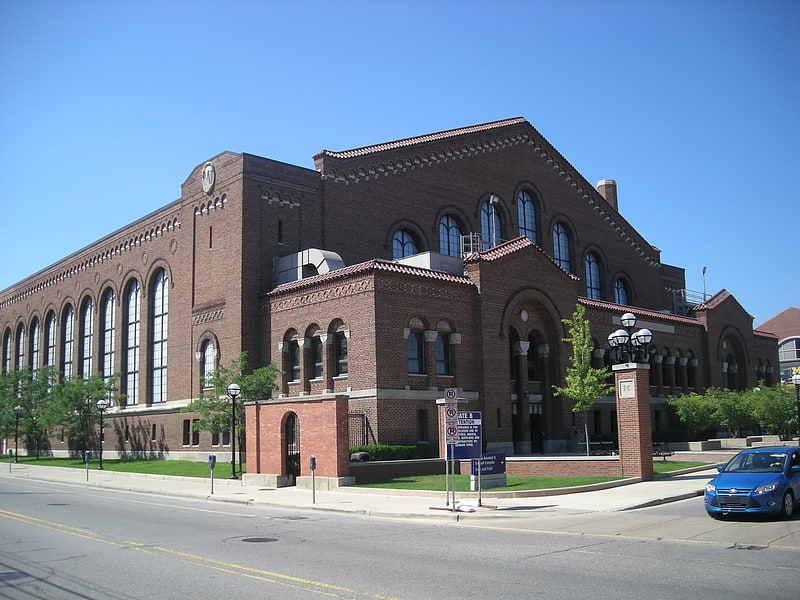
Arena in Ann Arbor, Michigan. Yost Ice Arena, formerly the Fielding H. Yost Field House, is an indoor ice hockey arena located on the campus of the University of Michigan in Ann Arbor, Michigan. It is the home of the Michigan Wolverines men's ice hockey team which plays in the Big Ten Conference. The building opened in 1923 and was the home of the men's basketball until the Crisler Center opened in 1967. It was converted for use as an ice arena in 1973 and has been home of the men's ice hockey team since then and to the women's ice hockey club team since their establishment in 1994.[4]
Address: 1116 S State St, 48104-3787 Ann Arbor (Central Ann Arbor)
Nickels Arcade
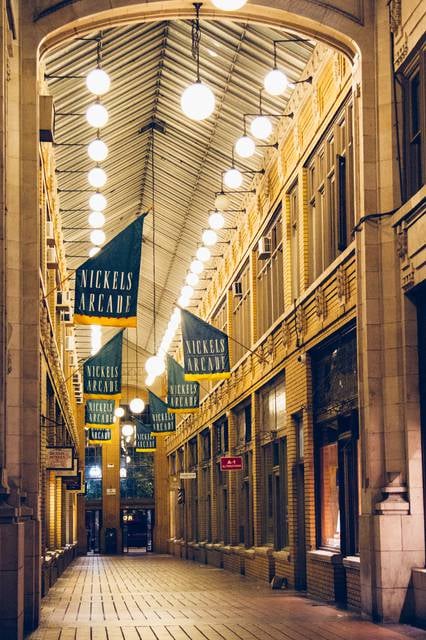
Arcade in Ann Arbor, Michigan. Nickels Arcade is a commercial building located at 326-330 South State Street in Ann Arbor, Michigan. It was listed on the National Register of Historic Places in 1987. The building is notable as perhaps the only remaining example in Michigan of a free-standing commercial arcade building of a type that was popularized by the Cleveland Arcade.[5]
Address: 326 S State St, 48104-2412 Ann Arbor (Central Ann Arbor)
St. Thomas the Apostle Catholic Church
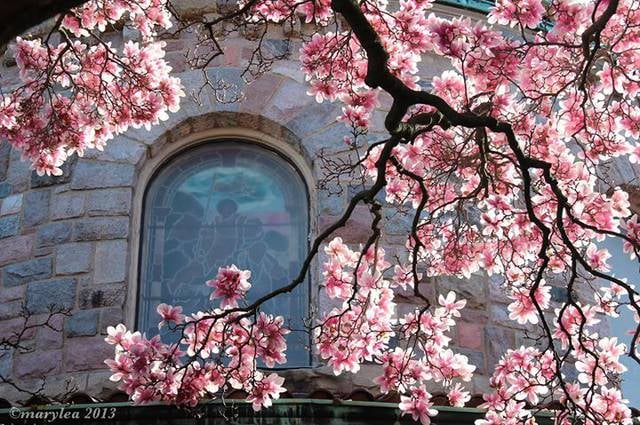
St. Thomas the Apostle Catholic Church is a parish of the Roman Catholic Church located in Ann Arbor, Michigan at 530-540 Elizabeth Street. Its historic parish church is listed as a Michigan State Historic Site.[6]
Address: 530 Elizabeth St, 48104-1222 Ann Arbor (Central Ann Arbor)
Kempf House

The Kempf House Museum, also known as the Henry Bennett House or the Reuben Kempf House, is a museum located at 312 South Division Street in Ann Arbor, Michigan. It was originally built as a single-family home in 1853. It was listed on the National Register of Historic Places in 1973.[7]
Address: 312 S Division St, 48104-2204 Ann Arbor (Central Ann Arbor)
Michigan Theater
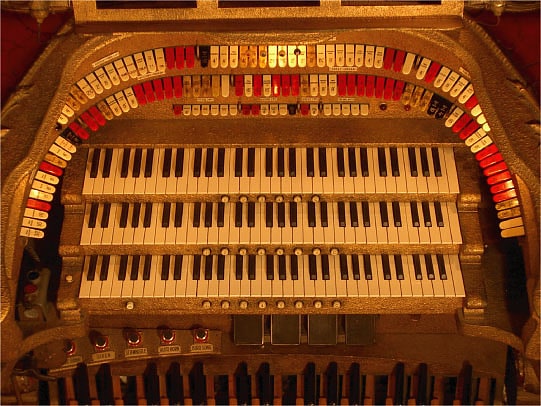
Auditorium in Ann Arbor, Michigan. The Michigan Theater is a movie palace in Ann Arbor, Michigan, United States. It shows independent films and stage productions, and hosts musical concerts.
Designed by Detroit-based architect Maurice Finkel and built in 1927, the historic auditorium seats 1610 and features the theater's original 1927 Barton Theatre Pipe Organ, orchestra pit, stage, and elaborate architectural details. It was built for and owned by Angelo Poulos and his heirs and was leased until 1978 to the Butterfield Theatres chain, who managed it along with Butterfield's nearby State Theater. Both theaters are now owned and managed by the non-profit Michigan Theater Foundation.[8]
Address: Ann Arbor, 603 E. Liberty St. Ann Arbor, Michigan
Hill Auditorium

Auditorium in Ann Arbor, Michigan. Hill Auditorium is the largest performance venue on the University of Michigan campus, in Ann Arbor, Michigan. The auditorium was named in honor of Arthur Hill, who served as a regent of the university from 1901 to 1909. He bequeathed $200,000 to the university for the construction of a venue for lectures, musical performances, and other large productions. Opened in 1913, the auditorium was designed by Albert Kahn and Associates. It was renovated by the same firm beginning in 2002 and was re-opened in 2004.
With seating for up to 3,538 (originally 4,100 prior to the 2004 renovation) audience members, Hill is used for large productions on campus.[9]
Address: 825 N University Ave, 48109-1004 Ann Arbor (Central Ann Arbor)
Nichols Arboretum
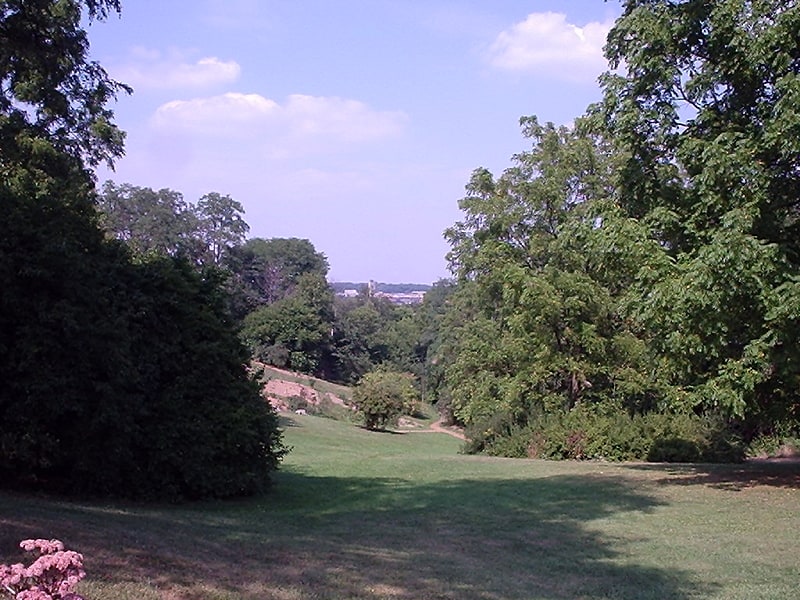
Park in Washtenaw County, Michigan. Nichols Arboretum, locally known as the Arb, is an arboretum operated by the University of Michigan. Located on the eastern edge of its Central Campus at 1610 Washington Heights in Ann Arbor, Michigan, the Arboretum is a mosaic of University and City properties operated as one unit. The arboretum is open daily from sunrise to sunset with no charge for admission. The Huron River separates a northern section of the arboretum's floodplain woods; the railroad marks the northern border.
The arboretum was designed in 1906 by O. C. Simonds, and he used the steep glacial topography to include areas both for collections and natural areas. Many of the older plantings date from the 1920s and 1930s. It is particularly known for its Peony Collection, Heathdale Collection (species primarily from Appalachia), the Centennial Shrub Collection and the Dow Prairie. The University of Michigan conducts controlled burns of the prairie each year in an attempt to maintain native species and habitat.
Students flock to the Arb for a variety of outdoor activities beyond assigned studies, such as jogging, picnicking, and sun-bathing. Maps are posted, which include the length and type of trail (gravel, stairs, etc.). The Arb is a common spot for Ann Arbor's students to gather. During winter, students have been known to go sledding in the Arb using cafeteria trays from university dining halls. In recent summers, the Arb has been the site of Shakespeare in the Arb, dramatic performances of Shakespearean plays.[10]
Address: 1610 Washington Heights, Ann Arbor (Northeast Ann Arbor)
The Diag

Park in Ann Arbor, Michigan. The Diag is a large open space in the middle of the University of Michigan's Central Campus. Originally known as the Diagonal Green, the Diag derives its name from the many sidewalks running near or through it in diagonal directions. Many of the University's most frequented buildings are situated around the Diag, including West Hall, Randall Lab, the Shapiro Undergraduate Library, the Hatcher Graduate Library, and Angell, Mason, Haven, and Tisch Halls, among others.
In April 2008, spring commencement ceremonies were held at the Diag for the first time in the university's 191-year history, as the traditional commencement ceremony location, Michigan Stadium, was undergoing construction.[11]
Parker Mill

Park in Ann Arbor Charter Township, Michigan. The Parker Mill, also known as Parker Mill Park or Parker Mill Complex, is a mill located at 4650 Geddes Road, east of Ann Arbor, Michigan. The mill is a well-preserved example of a small-scale grist mill operation that was once common in Michigan. The mill and nearby Parker House were listed on the National Register of Historic Places in 1982.[12]
Address: 4650 Geddes Road, 48105 Ann Arbor
Kelsey Museum of Archaeology
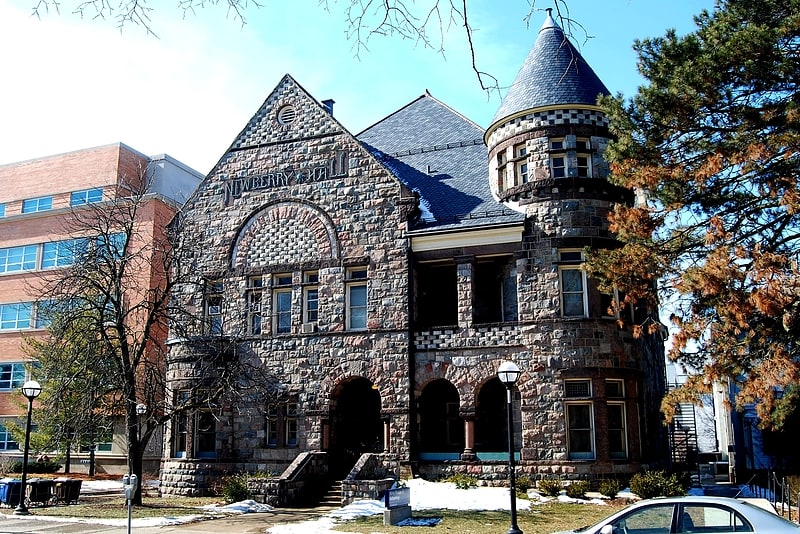
Museum in Ann Arbor, Michigan. The Kelsey Museum of Archaeology is a museum of archaeology located on the University of Michigan central campus in Ann Arbor, Michigan, in the United States. The museum is a unit of the University of Michigan's College of Literature, Science, and the Arts. It has a collection of more than 100,000 ancient and medieval artifacts from the civilizations of the Mediterranean and the Near East. In addition to displaying its permanent and special exhibitions, the museum sponsors research and fieldwork and conducts educational programs for the public and for schoolchildren. The museum also houses the University of Michigan Interdepartmental Program in Classical Art and Archaeology.[13]
Address: University of Michigan, 48109 Ann Arbor (Central Ann Arbor)
Argo Dam

The Argo Dam is a decommissioned hydroelectric barrage dam crossing the Huron River. It is located in the city of Ann Arbor in Washtenaw County in the U.S. state of Michigan. It was built by the Detroit Edison Company in 1920 for hydroelectricity before being decommissioned in 1959 and sold to the city of Ann Arbor in 1963. The surrounding area is used for recreational purposes, including Argo Nature Area and Bandemer Park.[14]
Argus Museum
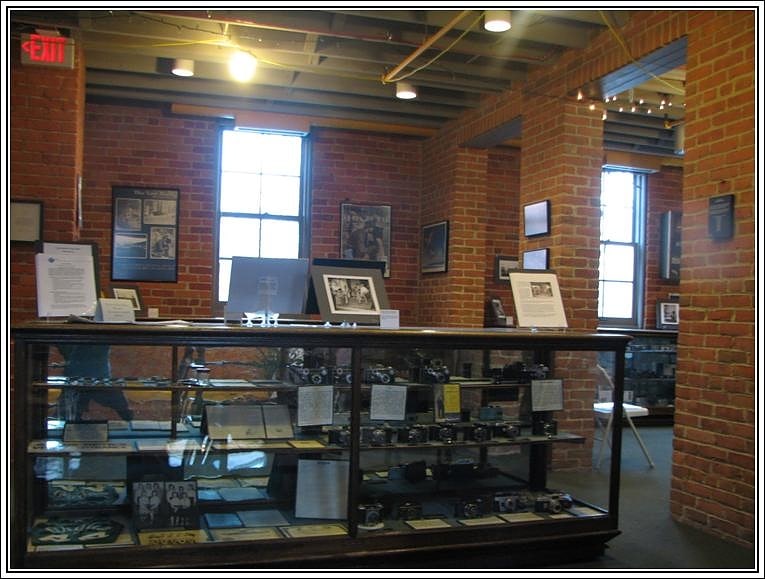
Museum in Ann Arbor, Michigan. The Argus Museum, located on the second floor of 525 West William, Ann Arbor, Michigan, features products manufactured by the Argus camera company and tells the stories of the company, the people involved and showcases unique collections connected to Argus. The museum is housed in the Argus I Building, which was one of the facilities where Argus products were manufactured.
The mission of the Argus Museum is to collect and preserve Argus Camera Incorporated products (including those manufactured under its prior names), publications and history of the company and its employees, to research the products and the people who were involved in the development and manufacturing of these products, to insure these collections are available for others to research, and to interpret and display the collections for public viewing to promote knowledge and appreciation of Argus.[15]
Address: 525 W William St, Ann Arbor (Central Ann Arbor)
Ann Arbor Hands-On Museum
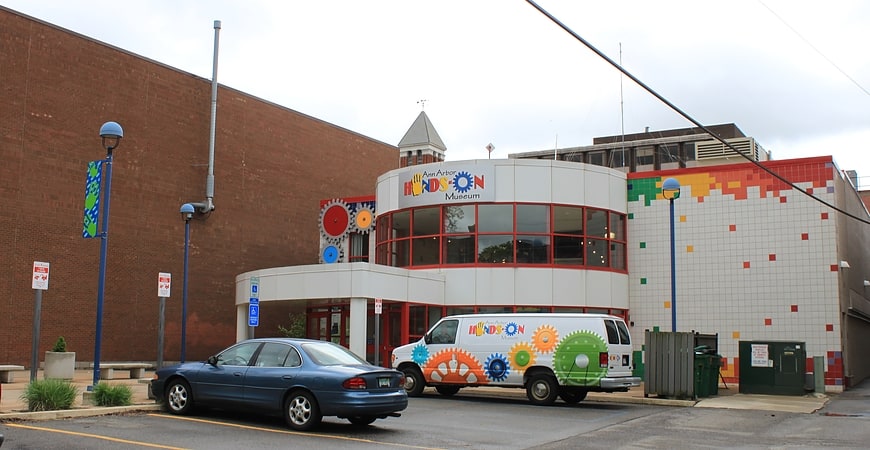
Museum in Ann Arbor, Michigan. The Ann Arbor Hands-On Museum, located in Ann Arbor, Michigan, United States, specializes in interactive exhibits with the goal of helping both children and adults discover the scientist within them by promoting science literacy through experimentation, exploration, and education.[16]
Address: 220 E Ann St, 48104-1445 Ann Arbor (Central Ann Arbor)
University of Michigan Central Campus Historic District
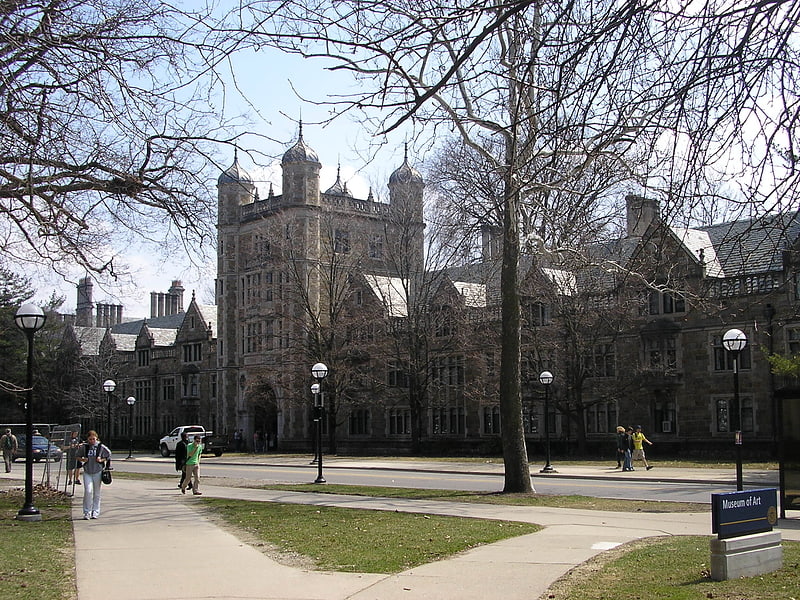
The University of Michigan Central Campus Historic District is a historic district consisting of a group of major buildings on the campus of the University of Michigan in Ann Arbor, Michigan. It was listed on the National Register of Historic Places in 1978.[17]
Ann Arbor Veterans Memorial Arena
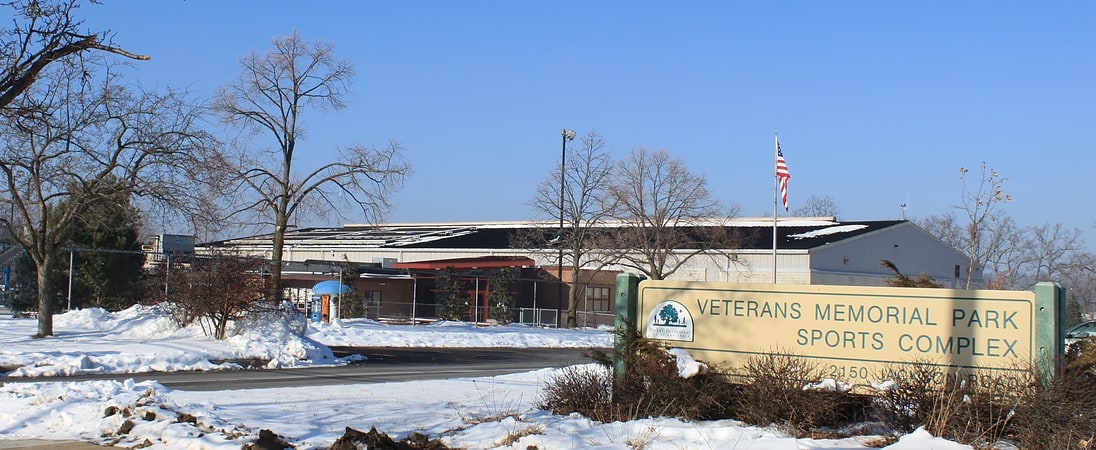
Arena in Washtenaw County. Ann Arbor Veterans Memorial Arena is an 800-seat indoor arena located in Ann Arbor, Michigan. It is used primarily for ice hockey, and is home to high school and recreational ice hockey teams.
It is part of Ann Arbor Veterans Memorial Park, and contains a Pro Shop, concessions and vending machines.[18]
Address: 2150 Jackson Street, 48103 Ann Arbor (West Ann Arbor)
The Ark
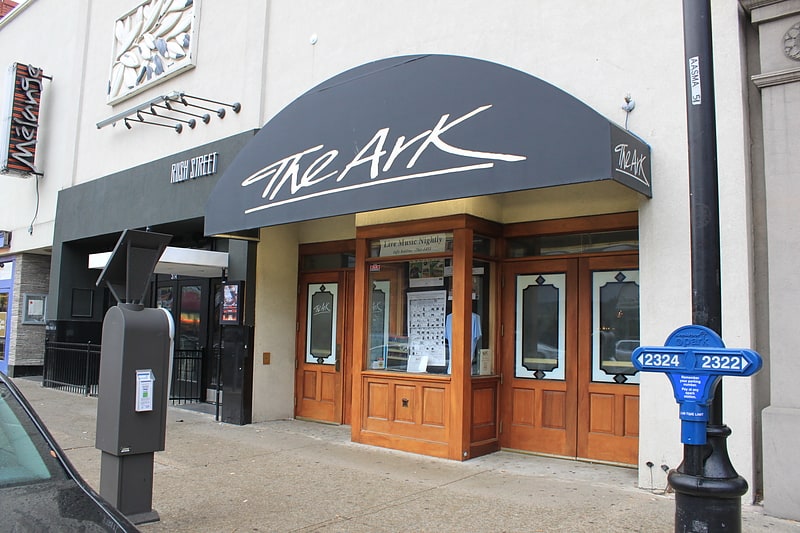
Non-profit organization in Ann Arbor, Michigan. The Ark, in Ann Arbor, Michigan, is a nationally known acoustic and folk music venue. It has been in existence in various locations since 1965. It currently seats about 400 and features more than 300 live performances each year.
Artists who have performed at The Ark include The Tallest Man on Earth, Lady Lamb, the Verve Pipe, John Paul White and His Band, Los Lonely Boys, the Milk Carton Kids, Mary Chapin Carpenter, Priscilla Ahn, Tom Paxton, Judy Collins, Arlo Guthrie, The Avett Brothers, Ani DiFranco, Birds of Chicago, The Proclaimers, Mandolin Orange, Ladysmith Black Mambazo, and Lissie.
The improv comedy group The Second City has performed there as well.[19]
Address: 316 S Main St, 48104-2108 Ann Arbor (Central Ann Arbor)
Detroit Observatory
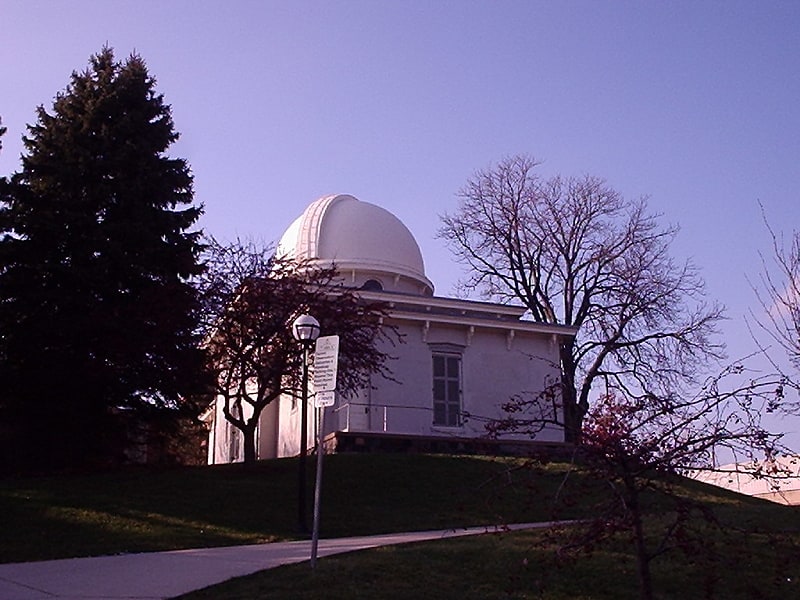
Observatory in Ann Arbor, Michigan. The Detroit Observatory is located on the corner of Observatory and Ann streets in Ann Arbor, Michigan. It was built in 1854, and was the first scientific research facility at the University of Michigan and one of the oldest observatories of its type in the nation. It was designated a Michigan State Historic Site in 1958 and placed on the National Register of Historic Places in 1973.[20]
Address: 1398 E Ann St, 48109 Ann Arbor (Central Ann Arbor)
Blind Pig
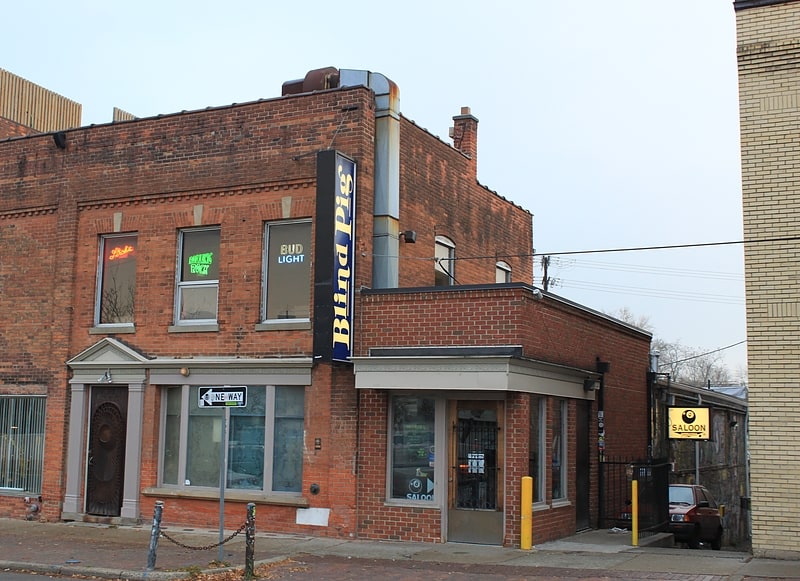
Music venue in Ann Arbor, Michigan. The Blind Pig is a music venue in Ann Arbor, Michigan. The club was established as a home for blues musicians, although today it books predominantly indie rock acts and local groups.[21]
Address: 208 S 1st St, 48104 Ann Arbor (Central Ann Arbor)
Cobblestone Farm and Museum
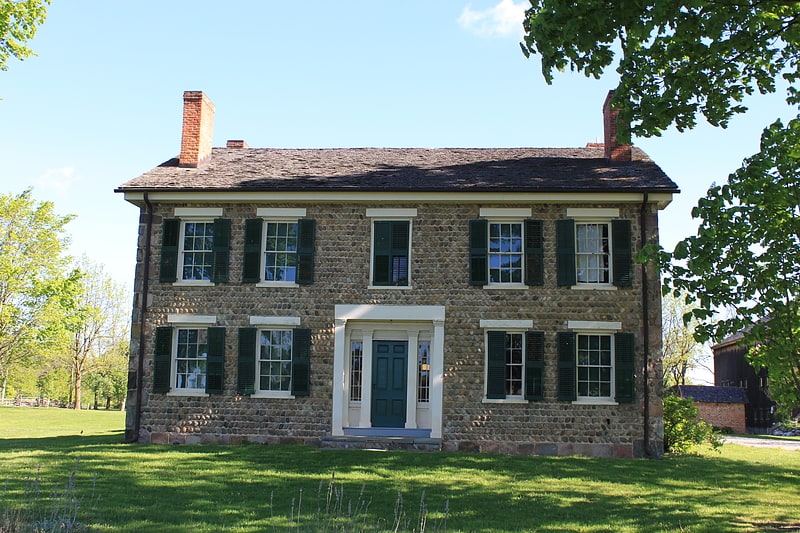
Museum. The Cobblestone Farm and Museum, which includes the Dr. Benajah Ticknor House is an historical museum located at 2781 Packard Road in Ann Arbor Michigan. The museum gets its name from the cobblestone used to build the farmhouse. It was listed on the National Register of Historic Places in 1972 and designated a Michigan State Historic Site in 1973.[22]
Address: 2781 Packard St, 48108-3236 Ann Arbor (South Ann Arbor)
State Theater
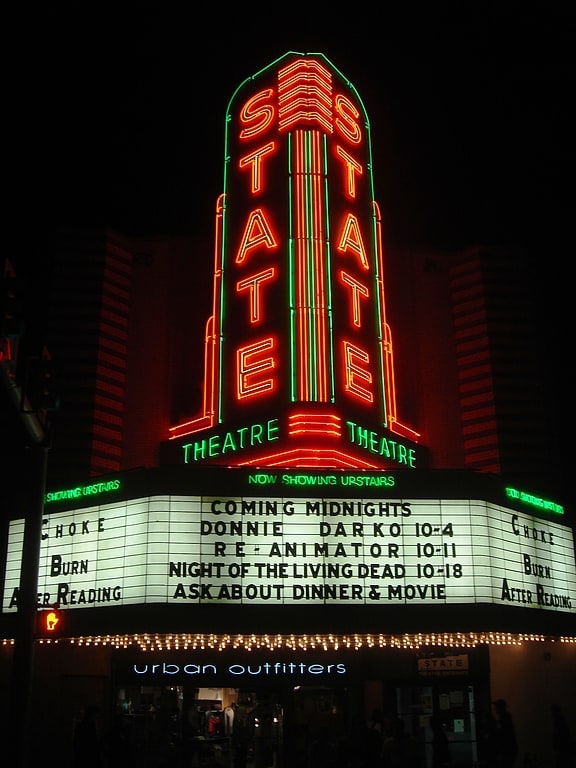
Movie theater in Ann Arbor, Michigan. The State Theatre is an operational former movie palace in Ann Arbor, Michigan, designed by C. Howard Crane in the Art Deco style.
The State was built by W.S. Butterfield Theaters, which also operated the nearby Michigan Theater. The non-profit Michigan Theater Foundation has operated the theater since 1999, complementing the Michigan's programming. The State's current 4 screens are located on the balcony of the former 1900-seat auditorium. A ground-floor retail space replaced the original auditorium's main floor in 1989, housing an Urban Outfitters store until 2020. It now hosts a Target.
The theater's central location and distinctive green, yellow and red marquee have made it an icon of Ann Arbor's downtown.[23]
Address: 233 S State St, Ann Arbor (Central Ann Arbor)
Penny W. Stamps School of Art & Design
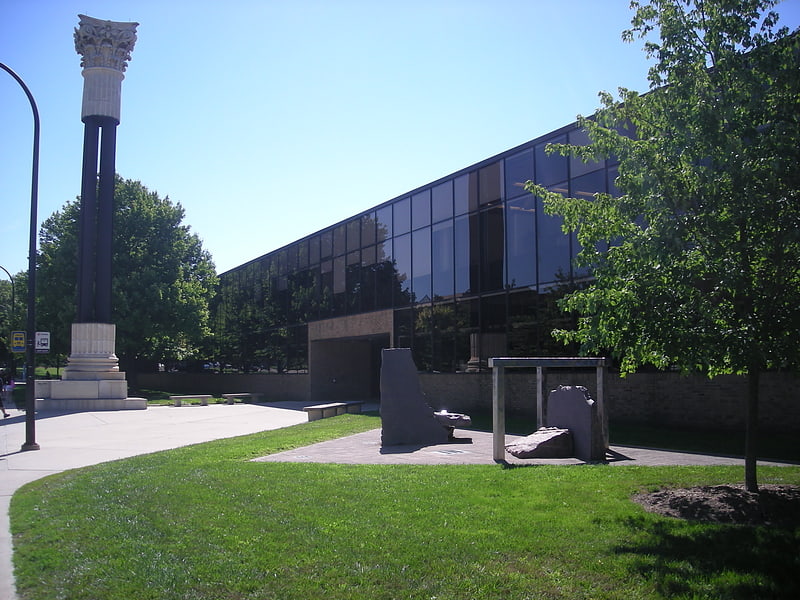
The Stamps School of Art & Design, officially the Penny W. Stamps School of Art & Design is the school of art and design at the University of Michigan located in Ann Arbor, Michigan. The school offers graduate and undergraduate degrees in art and design.
Established as an independent unit in 1974, A&D is one of 19 schools and colleges at the University of Michigan. It is fully accredited by the National Association of Schools of Art and Design (NASAD). The Penny W. Stamps School of Art & Design's academic programs and projects focus on generating new creative work, integrating the cultures of art and design, and engaging with the University, region, and national and international communities. In 2012, it was named for Penny and E. Roe Stamps in honor of their longtime support of the school, which included a $32.5 million gift in September 2012.[24]
Address: 2000 Bonisteel Blvd, Ann Arbor (Northeast Ann Arbor)
Washtenaw County Administration Building
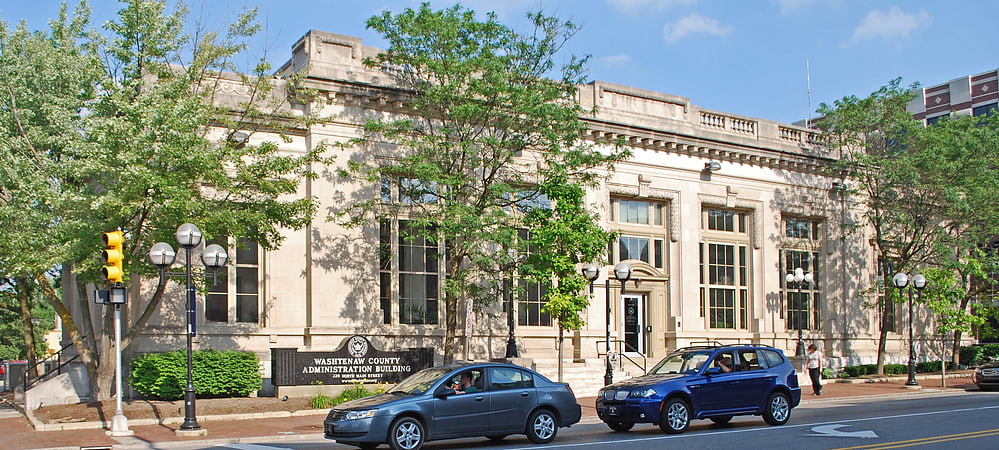
The Washtenaw County Administration Building is a former post office located at 220 North Main Street in Ann Arbor, Michigan. The building is now owned by Washtenaw County, Michigan. It was listed on the National Register of Historic Places in 1978.[25]
Address: 220 North Main Street, Ann Arbor (Central Ann Arbor)
Lurie Tower
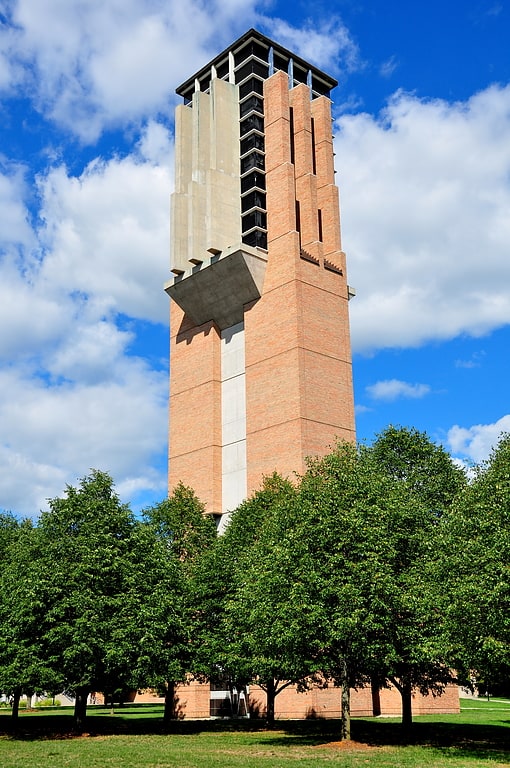
Building in Ann Arbor, Michigan. The Ann and Robert H. Lurie Tower, a memorial built in 1996 for Michigan alumnus Robert H. Lurie, is located on North Campus at the University of Michigan in Ann Arbor. It houses a 60-bell grand carillon, one of the university's two grand carillons; the other is housed in Burton Tower on Central Campus. These are two of only 23 grand carillons in the world.
The Lurie Tower was designed by Michigan alumnus Charles Moore (AB '47, Hon Arch Ph.D. '92), with structural engineering done by Robert M. Darvas Associates. The tower was dedicated in October 1996. A gift of the "Ann and Robert H. Lurie Family Foundation," it has 60 bells. Ann Lurie of Chicago donated $12 million in memory of her husband, Robert H. Lurie (BSE '64, MSE '66), to help fund the construction of North Campus buildings, including the bell tower. Completed in late 1995, the 167-foot (50.9 m) tall tower is a significant landmark on North Campus.
The bronze bells of the Lurie Carillon are lighter in weight than the bells of the carillon in Burton Memorial Tower. They were cast at the Royal Eijsbouts bell foundry in Asten, the Netherlands in the customary proportion of 80% copper to 20% tin. The North Campus bourdon bell weighs six tons.[26]
Burton Memorial Tower
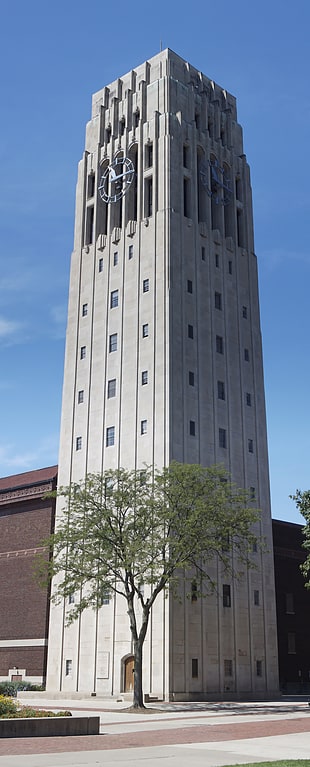
Tower in Ann Arbor, Michigan. The Burton Memorial Tower is a clock tower located on Central Campus at the University of Michigan in Ann Arbor at 230 North Ingalls Street. Housing a grand carillon, the tower was built in 1936 as a memorial for University President Marion Leroy Burton. This carillon is the world's fourth-heaviest, containing 53 bells and weighing a total of 43 tons.[27]
Address: 230 South Ingalls St, 48109 Ann Arbor (Central Ann Arbor)
Kellogg-Warden House
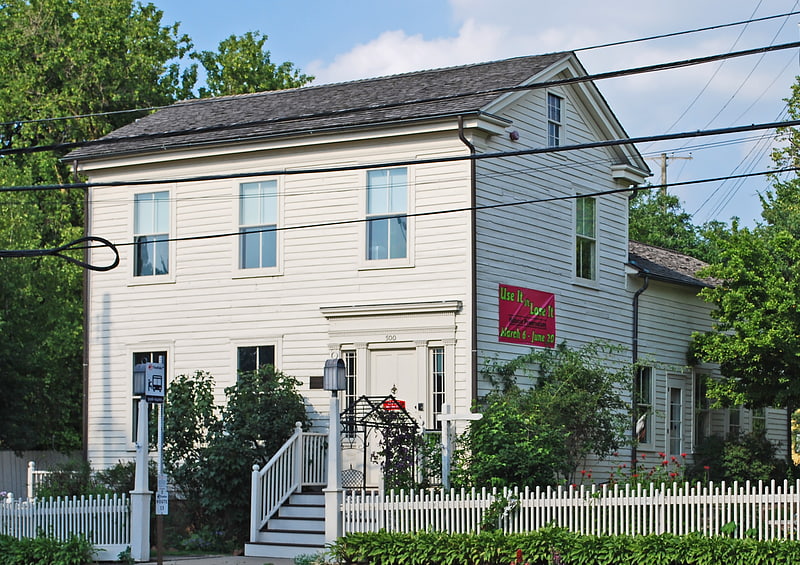
The Kellogg-Warden House is a single-family house located at 500 North Main Street in Ann Arbor, Michigan. It was listed on the National Register of Historic Places in 1994. It now houses the Washtenaw County Historical Society's Museum on Main Street.[28]
Gerald R. Ford Presidential Library
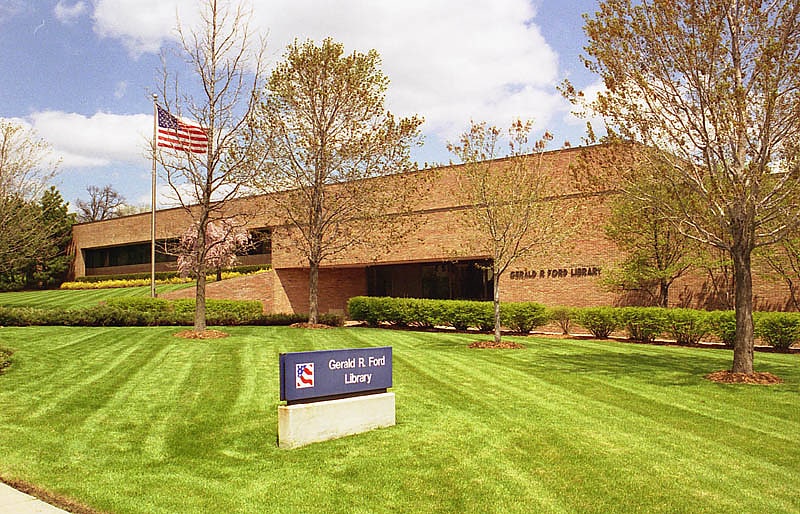
Archive in Ann Arbor Charter Township, Michigan. The Gerald R. Ford Presidential Library is a repository located on the north campus of the University of Michigan in Ann Arbor. The library houses archival materials on the life, career, and presidency of Gerald Ford, the 38th president of the United States. The Gerald R. Ford Presidential Library is a part of the National Archives and Records Administration's presidential library system.[29]
Address: 1000 Beal Ave, 48109-2114 Ann Arbor (Northeast Ann Arbor)
Buhr Park
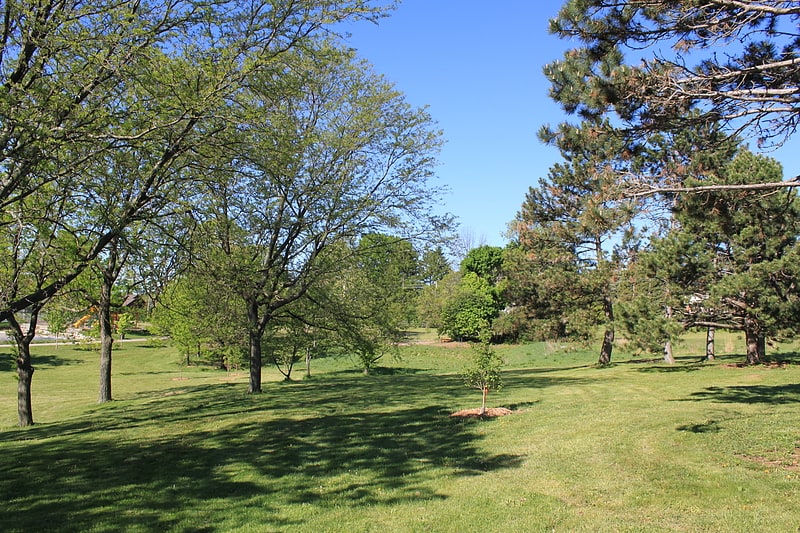
Park in Ann Arbor, Michigan. Buhr Park is a 39-acre public park in Ann Arbor, Michigan.
There is a large public swimming pool and a smaller children's wading pool with interactive toys. Buhr Park also includes 39 acres (160,000 m2) of rolling hills, picnic areas with barbecue grills, a children's play area, softball diamonds, soccer fields and outdoor tennis courts. The Cobblestone Farm and Museum is located on the park grounds.
The Buhr Outdoor Ice Arena and Cross Country Ski Center facilitates winter sports such as ice skating and hockey. It provides groomed trails for skiing set by snowmobile as well as rental, equipment, locker rooms, etc.
The Buhr Park Children's Wet Meadow is a group of wet meadow ecosystems designed as an educational opportunity for school-age children.[30]
Address: 2751 Packard St, 48108-3236 Ann Arbor (South Ann Arbor)
County Farm Park
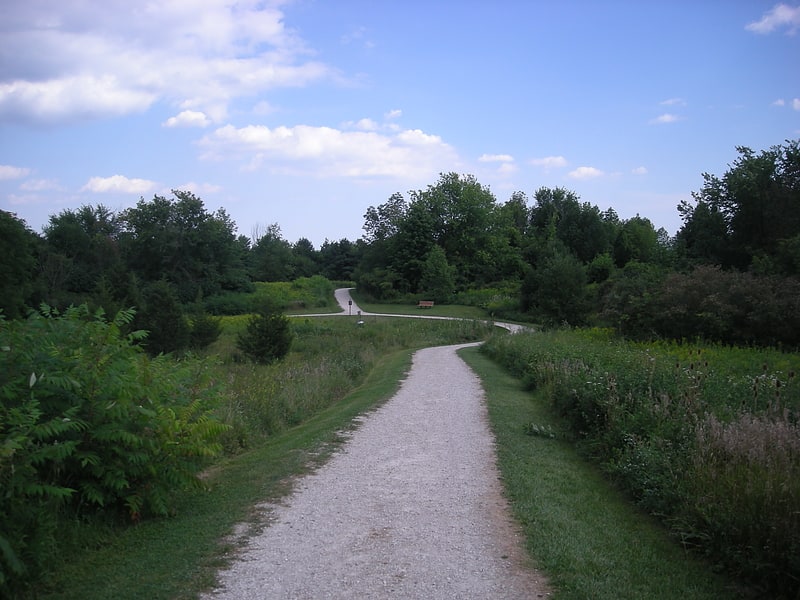
Park in Ann Arbor, Michigan. Nelson Meade County Farm Park is a 141-acre public park in eastern Ann Arbor, Michigan owned by Washtenaw County and operated by the county's Parks and Recreation Commission. Consisting of a mix of woodlands, fields, and gardens, the park is home to a wide variety of flora and fauna and is a popular local destination for gardening, hiking, jogging, and biking. The park has been county land since 1836, although for the majority of the nineteenth and twentieth centuries it was used as the county's poorhouse and then as its infirmary. In 1972, the site began transitioning to parkland with the creation of community gardens, and over the next couple decades various trails and a perennial garden were created. Since 2000, the park has experienced significant ecological restoration efforts, including the removal of invasive plants, prairie restoration, and the creation of a wet meadow during the restoration of Malletts Creek.[31]
Address: 2230 Platt Rd, 48104 Ann Arbor (South Ann Arbor)
William Palmer Residence
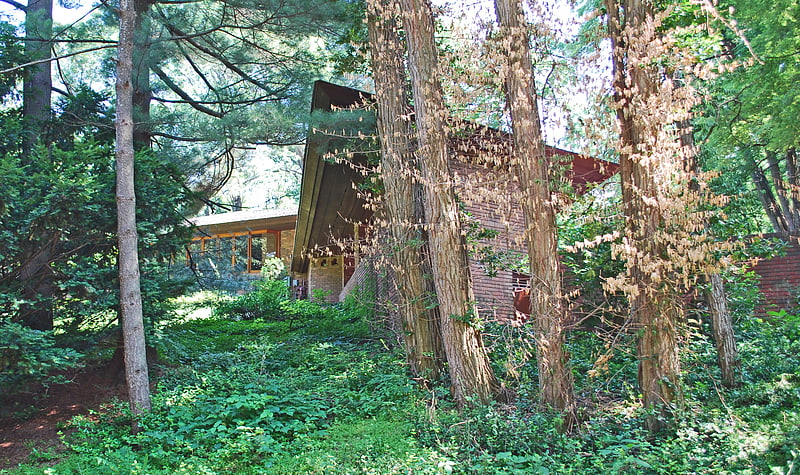
The William and Mary Palmer House is a house in Ann Arbor, Michigan, designed by Frank Lloyd Wright in 1952. The home was designed for William Palmer, an economics professor at the University of Michigan, and his wife Mary. It sits on three lots at the end of a quiet, dirt road cul-de-sac. The location is near the Nichols Arboretum, and less than a mile from the university.[32]
Address: 227 Orchard Hills Drive, Ann Arbor (Northeast Ann Arbor)
Forest Hill Cemetery
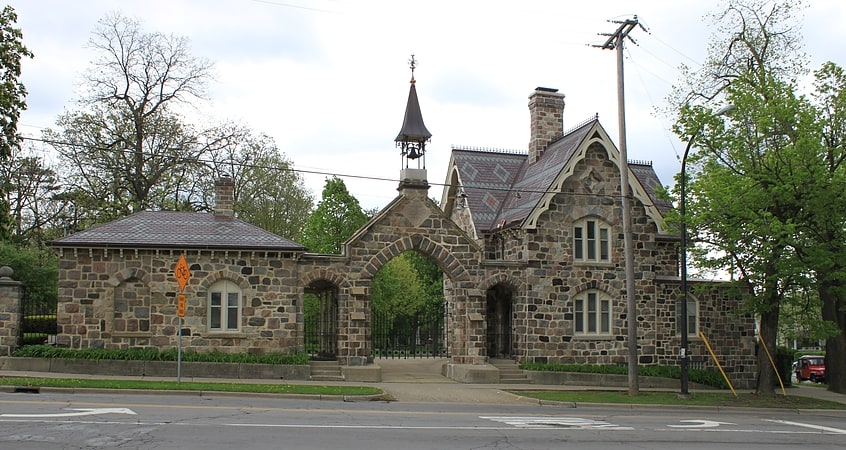
Cemetery in Ann Arbor, Michigan. Forest Hill Cemetery in Ann Arbor, Michigan is a 65-acre cemetery founded in 1857. A civil engineer named James Lewis Glenn designed the cemetery in the rural or garden style popular in the second half of the 19th century. The cemetery's main gate was designed by James Morwick in the Gothic Revival style. Gordon W. Lloyd, a leading architect based in Detroit, Michigan, designed the cemetery's gatehouse and sexton's residence, also in the Gothic Revival style.
In 1859 Dr. Benajah Ticknor was the first person to be buried in Forest Hill. Ticknor had been a surgeon in the U.S. Navy and the owner of property now known as Cobblestone Farm in Ann Arbor.
Prior to the establishment of the cemetery, Chi Psi fraternity built the nation's first fraternity building (a hunting lodge) on the site, in 1849.[33]
Address: 415 Observatory St, Ann Arbor (Northeast Ann Arbor)
Dixboro General Store
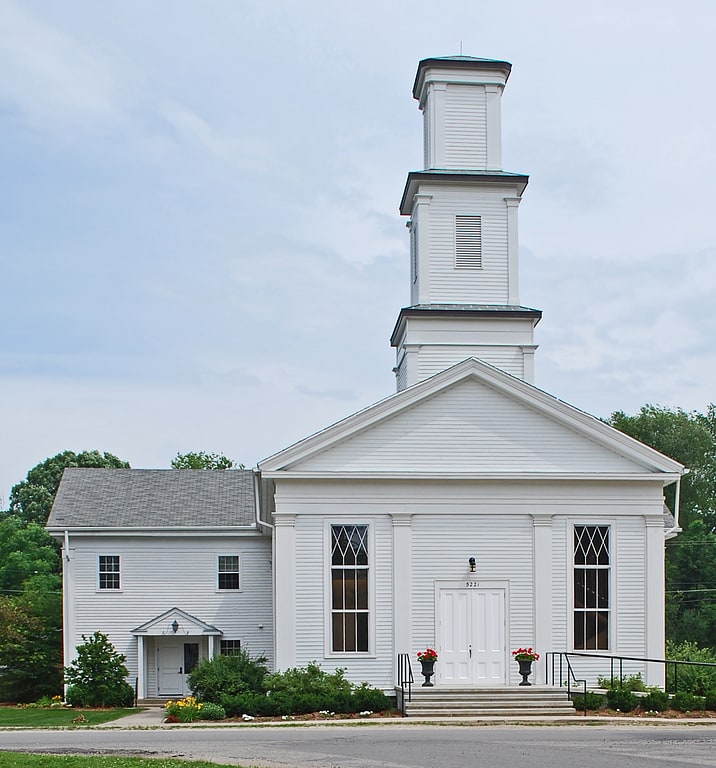
United methodist church in Superior Township, Michigan. Dixboro United Methodist Church is a historic church located at 5221 Church Street in Dixboro, Michigan. It was added to the National Register of Historic Places in 1972 and designated a Michigan State Historic Site in 1971. It is significant as a nearly unaltered example of a mid-19th century Greek Revival-style church designed by a professional architect.[34]
Address: 5206 Plymouth Rd, 48105-9520 Ann Arbor
Weiser Hall
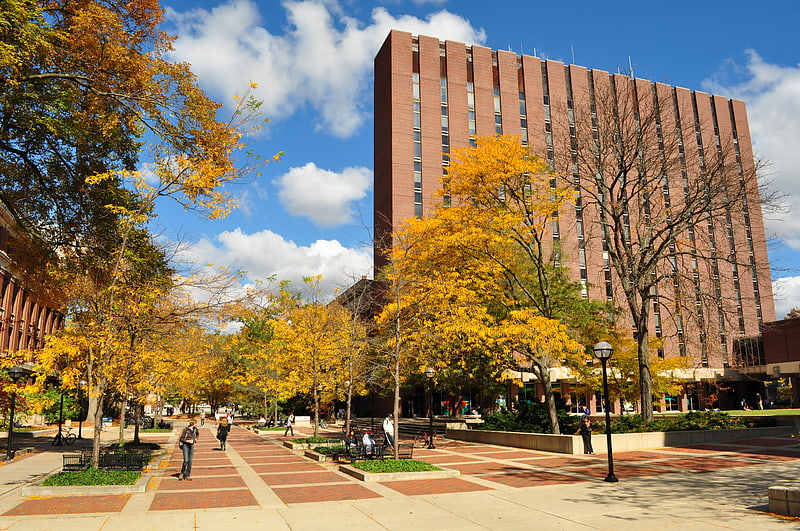
Building in Ann Arbor, Michigan. Weiser Hall is located in the heart of central campus at the University of Michigan campus in Ann Arbor, Michigan.
It was originally built in 1963 by Albert Kahn Associates, as the David M. Dennison Building. Weiser Hall was renamed in 2014 in recognition of U-M alumni and donors Ronald Weiser and Eileen Weiser. The building underwent a complete renovation reopening in September 2017.
The extensive renovation undertaken by architectural firm Diamond Schmitt Architects involved completely gutting and rebuilding the entire tower. The brick on the tenth floor south side, and the entire southwest corner of every floor was removed and replaced by glass resulting a tenth floor event space with catering kitchen and stunning views of the city of Ann Arbor through the floor to ceiling south facing wall of glass, and now houses four beautiful two-story common rooms and kitchens on every second floor - complete with four two-story green walls.
The building is now home to a number of interdisciplinary and internationally-focused units within the College of Literature, Science, and the Arts, and is a center for active and engaged learning.
Currently located in the Weiser Hall hi-rise:
- Center for Global and Intercultural Study (CGIS)
- Community-Engaged Academic Learning (CEAL)
- International Institute
- Michigan Institute for Data Science (MIDAS)
- Center for the Study of Complex Systems (CSCS)
- Center for the Study of Black Youth in Context (CSBYC)
- Organizational Studies
- Barger Leadership Institute
- Weinberg Institute for Cognitive Science
- English Language Institute (ELI)
The International Institute is the largest of the current tenants with three floors of offices housing several regional and academic sub-units.
The low-rise section contains a number of large lecture halls; and the Physics Demonstration Lab in the lower level. The two sections are connected by a breezeway on the second floor.[35]